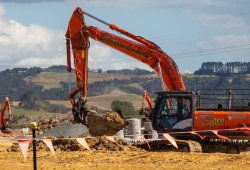New Data Shows 1 In 9 Children Under The Age Of Five Lives In A Multi-family Household
Newly released data shows that 1 in 9 children under the age of five lived in a household with more than one family at the time of the 2018 Census, Stats NZ said today.
In Auckland, this proportion was around one in six, with the highest rates in Māngere-Ōtāhuhu and Ōtara-Papatoetoe. In these areas, more than one in four under-five year-olds lived in a household with two or more families, at 28.1 and 28.9 percent respectively.
Multi-family households tended to be larger, with two-family households having an average of 5.6 people, and three-or-more-family households averaging 9.0 people. In comparison, one-family households had an average of 3.1 people living in them.
“While the census recorded just under 3,400 households with three or more families, over 30,500 people lived in such households, and almost two-thirds of these households were in Auckland,” senior manager census data delivery Susan Hollows said.
The study Finding the crowding index that works best for New Zealand: Applying different crowding indexes to Census of Population and Dwellings data for 1986–2006 shows that multi-family households are more likely to experience crowding.
The 2018 Census recorded 1.65 million households in Aotearoa New Zealand. Nationally, the most common household type was ‘couples with children’. There were over 434,000 couple-with-children households, representing more than one-quarter of all households (27.3 percent). This was a similar proportion to the two previous censuses (2006 and 2013). In 2018, around half of couple-with-children households had either one or no dependent children (a child in a family who is under 18 years of age and not in full-time employment).
Almost half of all households (48.3 percent) consisted of either a couple with no children or one person living on their own. As indicated in Subnational family and household projections: 2013(base)–2038, this proportion is expected to increase as our population ages.
New Zealand households reflecting life stages
The living situations of people in New Zealand are different for the young and the old. Around two-thirds (66.6 percent) of children aged under 15 years lived in a couple with children household at the time of the 2018 Census, while a further 14.5 percent of this age group lived in a one-parent-with-children household. The proportion of children living in a one-parent household increased with the child’s age. Around one in six children aged 10–14 years lived in a one-parent household.
By the time people are in their early 20s, living in more diverse household types — such as an ‘other multi-person household’ (for example, a group of unrelated people) — becomes more common. Around one in five 20- to 24-year-olds lived in an other multi-person household at the time of the 2018 Census. For those aged 65 years and older, around three-quarters lived in either a one person or couple only household.
New Zealand households getting smaller
The average number of people per New Zealand household was 2.6 in 2018, a slight fall from an average of 2.7 people per household in the 2006 and 2013 Censuses.
Changes to the age structure of the population are likely to have contributed to this fall. Between 2006 and 2018, the proportion of children (aged 15 years and under) in the population fell from 21.5 percent to 19.6 percent. At the same time, the proportion of people aged 65 years and over increased from 12.3 percent to 15.2 percent.
The total fertility rate has also fallen since the mid-2000s.
Parenting and fertility trends in New Zealand: 2018
shows women both having fewer children and having children when they are older. In 2018, the median age of a mother at the time of her child’s birth was 30.5 years, compared with 25.7 years in 1980, 27.7 years in 1990, and 29.7 years in 2000.
Household size varying across the country
and
, in the North Island, were the territorial authorities with the largest average household size at 2.9 people per household. This was followed by
, in the South Island, with 2.8 people per household.
In comparison,
had the lowest average household size, with 2.0 people per household, followed closely by
and
, each averaging 2.1 people per household.
“Couple-only and one-person households are more common in areas with older populations,” Mrs Hollows said. “As a result, average household sizes tend to be smaller in these areas.”
Median ages in the Thames-Coromandel and Buller districts were 53.6 years and 49.6 years respectively, and around two-thirds of all households consisted of a couple or one person. In contrast, Auckland, Porirua City, and Selwyn District had much lower median ages at 34.7, 35.1, and 37.6 years respectively. Almost half of households in these areas consisted of one- or two-parent families (with or without others).
Buller District experienced the largest change in household size since the last census (down from an average of 2.3 people per household in 2013 to 2.0 people in 2018). This reflects a broader change in household composition in the area, with a 4.4 percentage point decrease in the proportion of couple-with-children households and a 5.1 percentage point increase in one-person households.
Within Auckland, there was considerable variation. South Auckland local boards had the largest average household size – at 3.7 people in
and 3.5 in
and
respectively. The news story
Almost 1 in 9 people live in a crowded house
explains that these local boards also had the highest rates of household crowding.
had the smallest average household size with 1.4 people, followed by
with 2.1 people per household on average. For more information about these areas, including data on housing, population, and ethnicity, see
.
New tables that include 2006, 2013, and 2018 Census data on families and households were released on 29 May. These tables allow us to explore family and household characteristics along with other variables, such as household income and tenure of household (whether a household owns or rents their home).
“These tables are a rich source of data that allow us to study how family and household composition varies over time and location. We can use this data to better understand how our society is changing,” Mrs Hollows said.
About families and households data
The use of administrative data to fill in some missing characteristics for people who are included in the family and household data has improved coverage and data quality for some family and household variables, compared with the 2013 Census. However, because we added people to the 2018 Census dataset from administrative sources, we did not always know where they are usually resident. This means we could not place them in families and households. This may lead to under-representation of some household types and ethnic groups. See the
Families and households in the 2018 Census: Data sources, family coding, and data quality
methodology paper for more information.
About the 2018 Census dataset
We combined data from the census forms with administrative data to create the 2018 Census dataset, which meets Stats NZ’s quality criteria for population structure information.
We added real data about real people to the dataset where we were confident the people should be counted but hadn’t completed a census form. We also used data from the 2013 Census and administrative sources and statistical imputation methods to fill in some missing characteristics of people and dwellings.
provides more information on the quality of the 2018 Census data. An independent panel of experts has assessed the quality of the 2018 Census dataset. The panel has endorsed Stats NZ’s overall methods and concluded that the use of government administrative records has improved the coverage of key variables such as age, sex, ethnicity, and place. The panel’s
Initial Report of the 2018 Census External Data Quality Panel
assessed the methodologies used by Stats NZ to produce the final dataset, as well as the quality of some of the key variables. Its second report
2018 Census External Data Quality Panel: Assessment of variables
assessed an additional 31 variables.
In its third report,
Final report of the 2018 Census External Data Quality Panel
, the panel made 24 recommendations, several relating to preparations for the 2023 Census. Along with this report, the panel, supported by Stats NZ, produced a series of graphs summarising the sources of data for key 2018 Census individual variables,
2018 Census External Data Quality Panel: Data sources for key 2018 Census individual variables
.
Quick guide to the 2018 Census (updated 16 September 2019)
outlines the key changes we introduced as we prepared for the 2018 Census and the changes we made once collection was complete.
The geographic boundaries are as at 1 January 2018.
See Statistical standard for geographic areas 2018
.
Definitions and metadata
provides information about methods and related metadata.
2018 Census information by variable and quality – DataInfo+
provides information about the variables and their quality.
Data quality ratings for 2018 Census variables
provides information on data quality ratings.


 Gordon Campbell: On When Racism Comes Disguised As Anti-racism
Gordon Campbell: On When Racism Comes Disguised As Anti-racism Labour Party: Public Transport Costs To Double As National Looks At Unaffordable Roading Project Instead
Labour Party: Public Transport Costs To Double As National Looks At Unaffordable Roading Project Instead The Treasury: New Paper On A Framework For Assessing The Economic And Fiscal Impacts Of Climate Change
The Treasury: New Paper On A Framework For Assessing The Economic And Fiscal Impacts Of Climate Change Government: Pet Bonds A Win/Win For Renters And Landlords
Government: Pet Bonds A Win/Win For Renters And Landlords Government: New Zealand Condemns Iranian Strikes
Government: New Zealand Condemns Iranian Strikes Environmental Defence Society: Calls For Fast-track Approvals Bill To Be Abandoned In Submission To Select Committee
Environmental Defence Society: Calls For Fast-track Approvals Bill To Be Abandoned In Submission To Select Committee Government: Roads Of National Significance Planning Underway
Government: Roads Of National Significance Planning Underway


